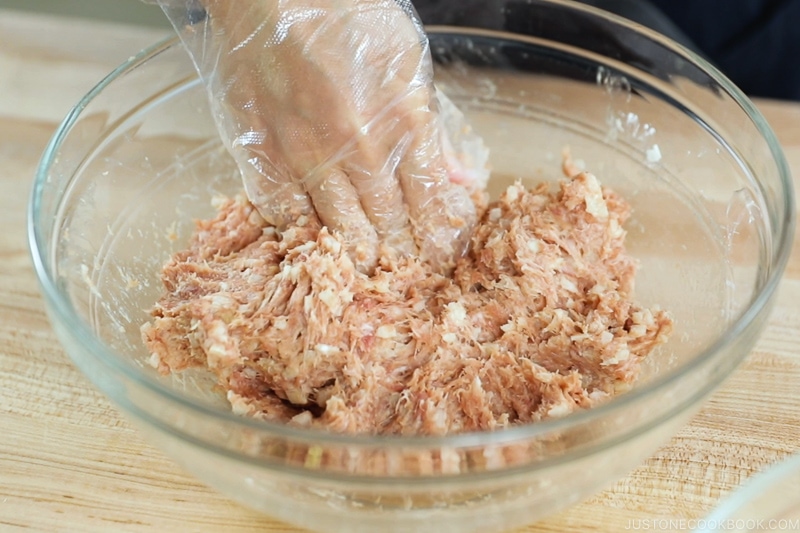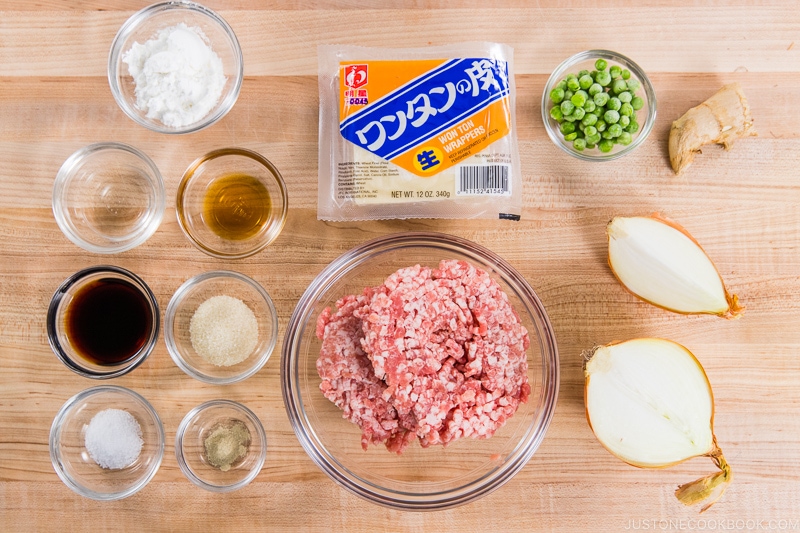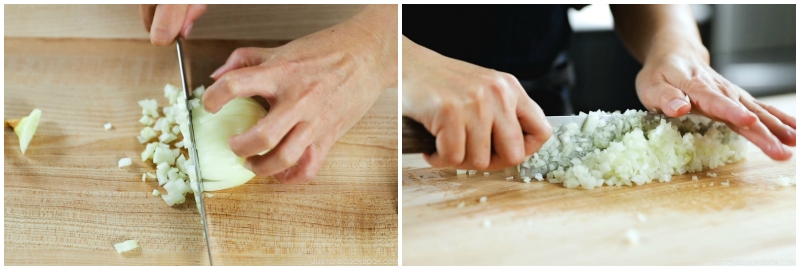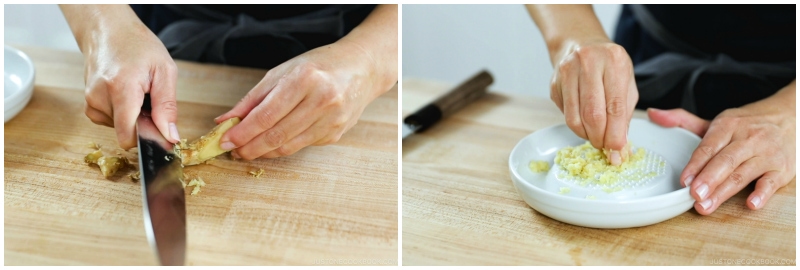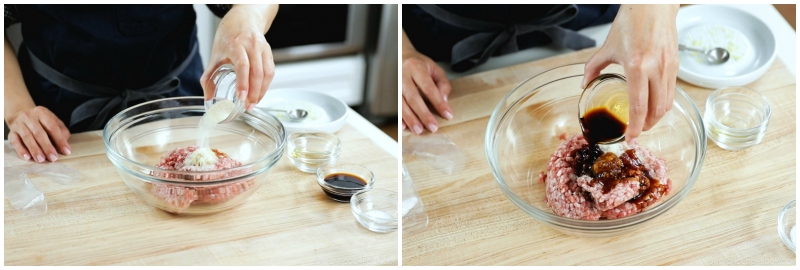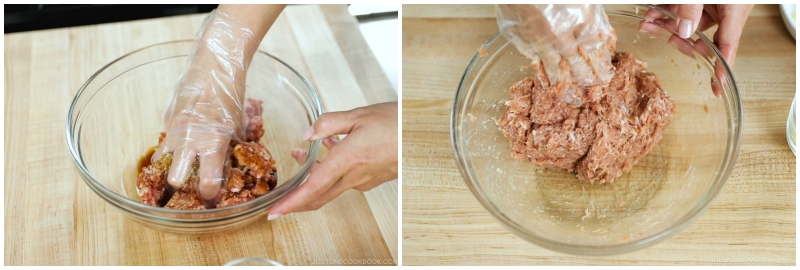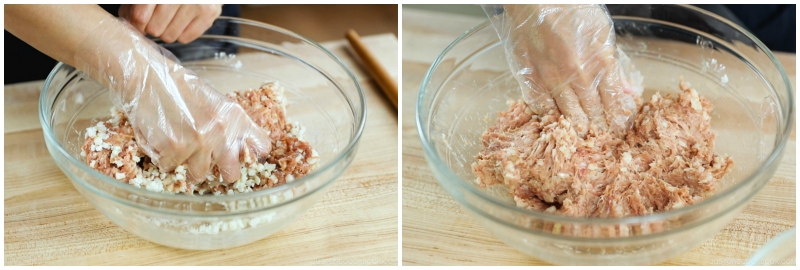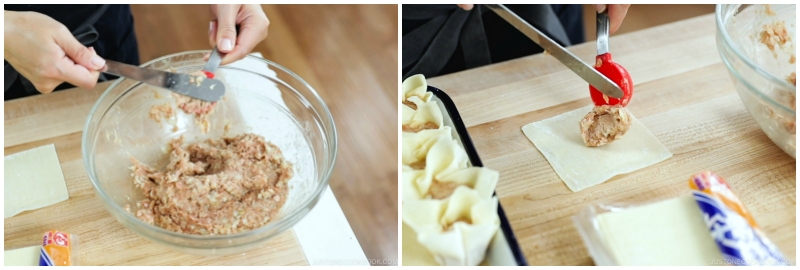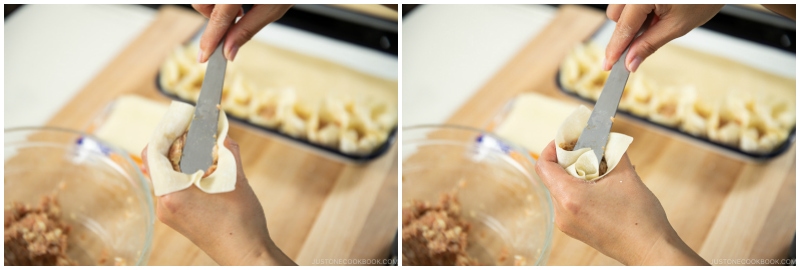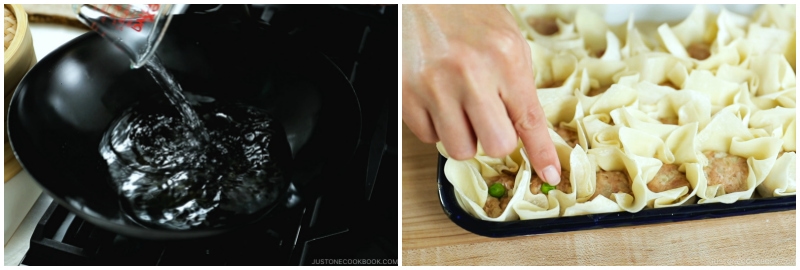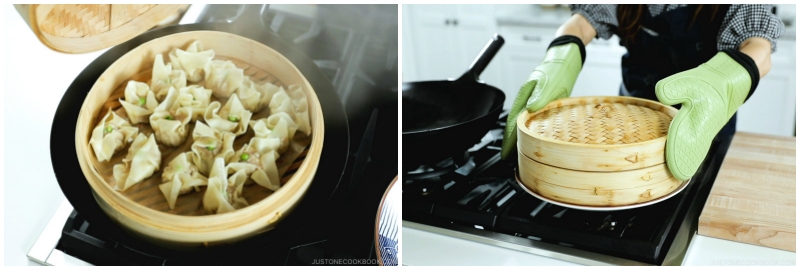Pork Shumai (Steamed Pork Dumplings) シュウマイ
Make fresh and juicy Japanese Shumai (Steamed Pork Dumplings) at home with ground pork and savory seasonings. They are perfect for a party appetizer or a weekend brunch. Introduced from China in 1928, Shumai are now a staple of Yokohama, Japan!
Yokohama Chinatown (横浜中華街, Yokohama Chūkagai) is Japan’s largest Chinatown, located in my hometown Yokohama. Its main attraction is the vast array of tantalizing Chinese cuisine restaurants and food stalls.
One of the most reputable restaurants is Kiyoken (崎陽軒), which has been serving Chinese food since the early 1900s. Their shumai (steamed pork dumplings) have been a popular and signature Yokohama souvenir for decades.
What’s Japanese-Style Pork Shumai?
Shumai (シュウマイ) in Japan typically contains ground pork and finely chopped onion, seasoned with a few Japanese condiments. The original Chinese shaomai or siumai (燒賣) commonly includes ground pork, chopped shrimp, and sometimes shiitake mushrooms, seasoned with oyster sauce, Shaoxing wine, and white pepper.
The easiest way to distinguish Japanese Shumai is by the dainty green peas that crown the open steamed dumplings, giving them their characteristic look.
You may associate Shumai with a dim sum dish or diner food, but in Japan, these steamed dumplings are a regular home-cooked dish, much like gyoza. Since Japanese-Chinese style dining can be expensive, most Japanese people make shumai from scratch or use a frozen premade bag.
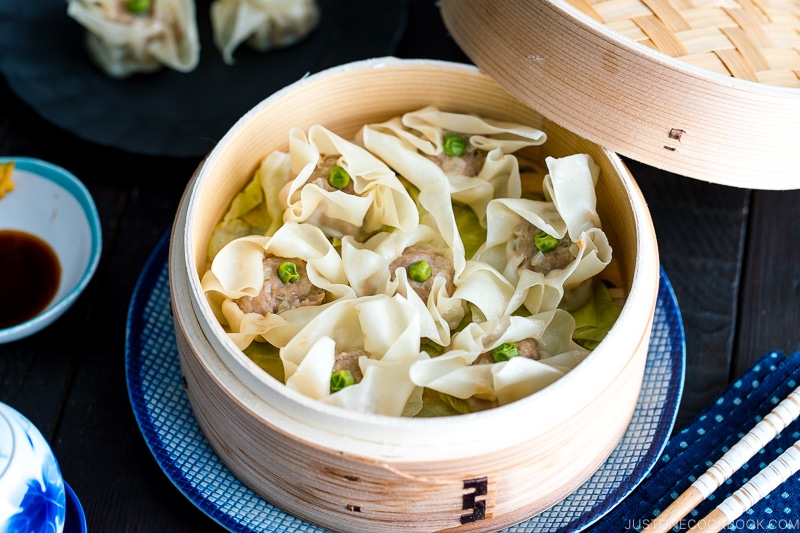
Ingredients
- Onion
- Ground pork – You can substitute it with any protein of your choice.
- Potato starch (cornstarch)
- Ginger
- Sake – Why sake? Learn here.
- toasted sesame oil, soy sauce, sugar, salt, white pepper powder
- Wonton wrappers (or Shumai wrappers)
- Green peas for decoration
Wonton or Shumai Wrappers
Japanese supermarkets sell “shumai wrappers” made specifically for Shumai. They come in thin, small, square sheets, different from the round gyoza wrappers.
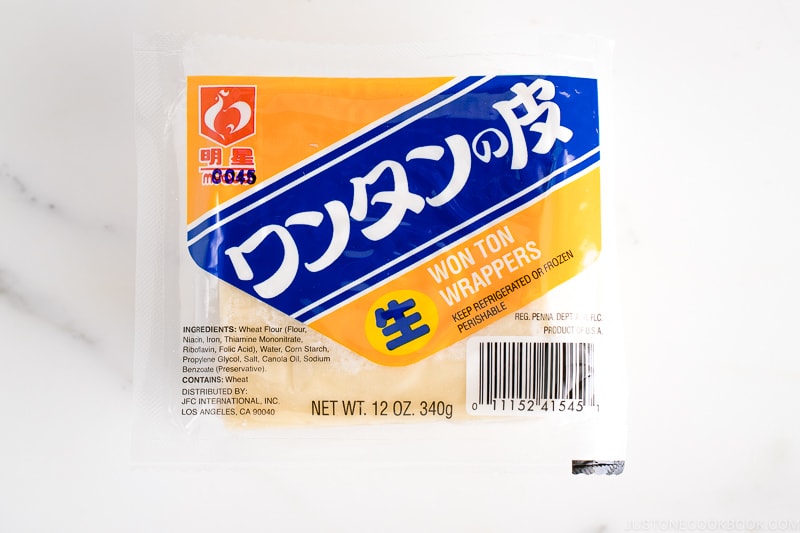
You can substitute with wonton wrappers. Depending on the brand, some dumpling wrappers are larger than others. If possible, I recommend choosing the smaller square ones.
How to Make Shumai – 3 Easy Steps!
- Make the meat filling for the dumplings.
- Wrap the shumai dumplings.
- Steam the dumplings!
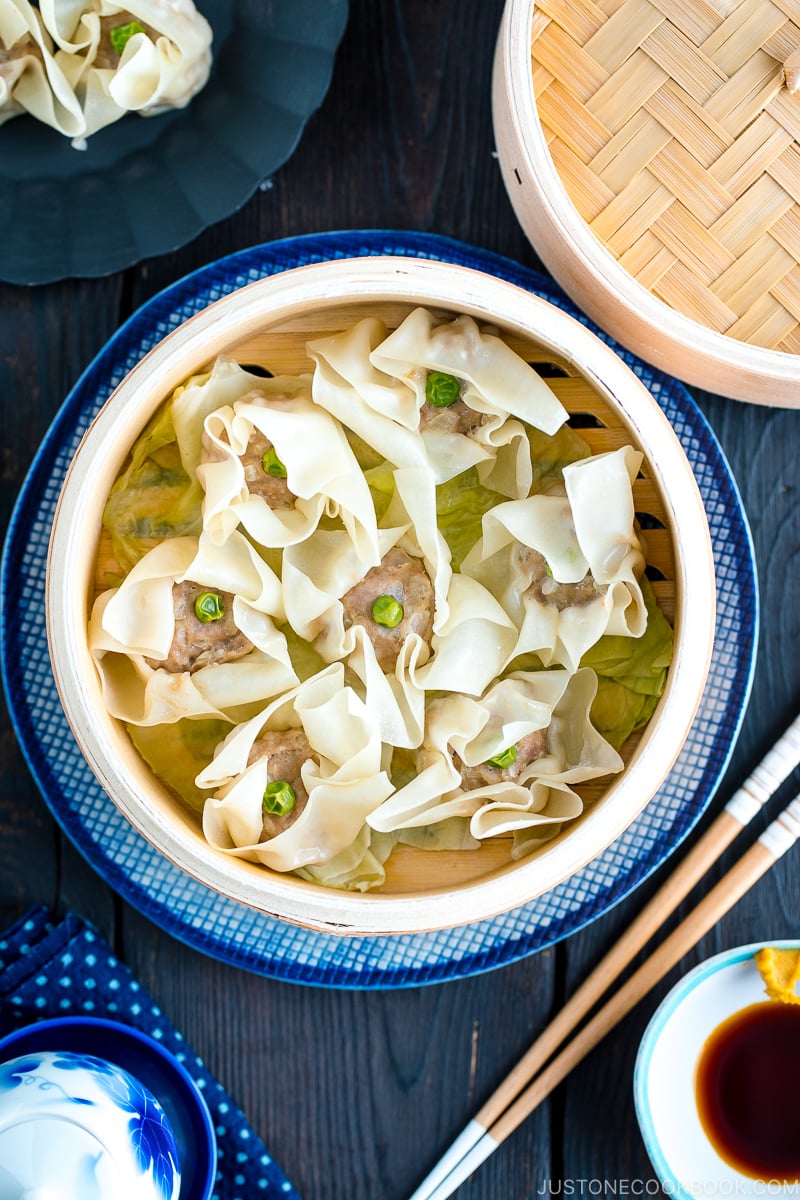
5 Tips on Filling & Wrapping
1. Mix potato starch/cornstarch with onion
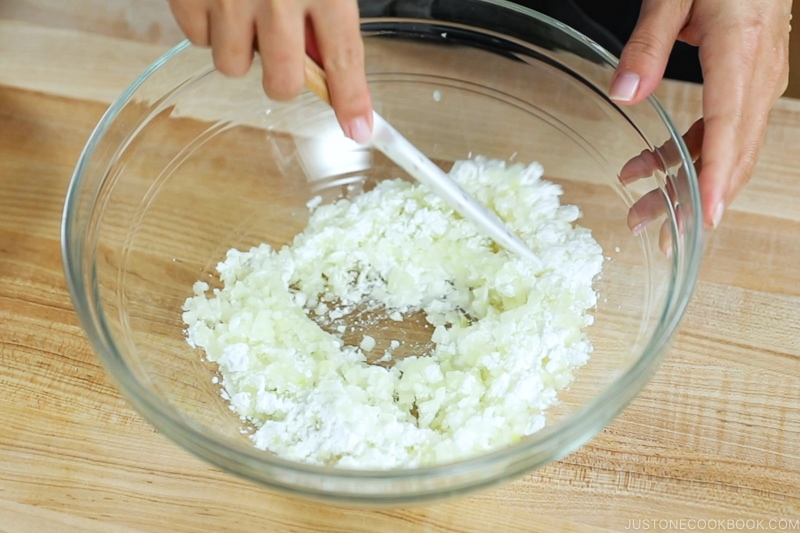
Potato starch (or cornstarch) plays an important role in absorbing excess moisture from the onion. You don’t want to break the wrappers with excess moisture later on!
2. Knead until sticky and pale
It’s crucial to use your hand (you can wear a plastic glove) to knead the meat mixture until it becomes sticky, pasty, and pale in color. This will ensure that the juices don’t escape, keeping all the delicious flavor within the meat.
3. Use a 1-tablespoon measuring spoon
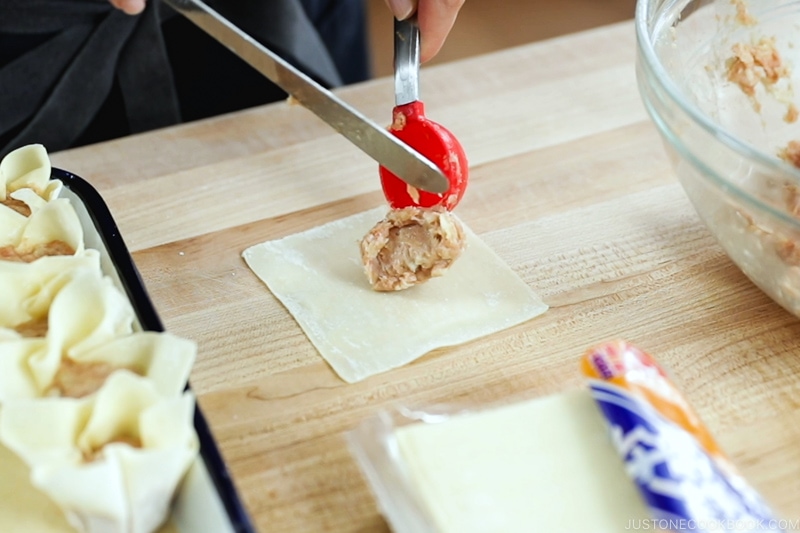
Using a measuring spoon ensures uniform portions for all your shumai. This way, you don’t have to worry about some shumai being undercooked while others are fully cooked. The dumplings will also have a uniform consistency. Once you’re familiar with the amount of mixture needed, you can use a butter knife or dumpling spatula.
4. Use a butter knife or the back of a teaspoon
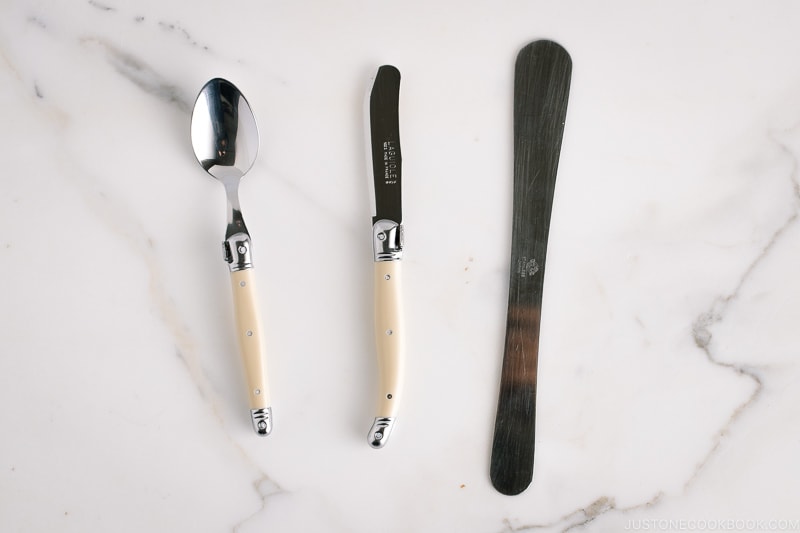
Use a non-sharp butter knife (if you have one) or the back of a teaspoon to stuff and press the filling into the wrappers. My friend in Japan gifted me a dumpling spatula (餃子ヘラ), and it has become a treasured item in my kitchen.
5. Press, rotate, and press…
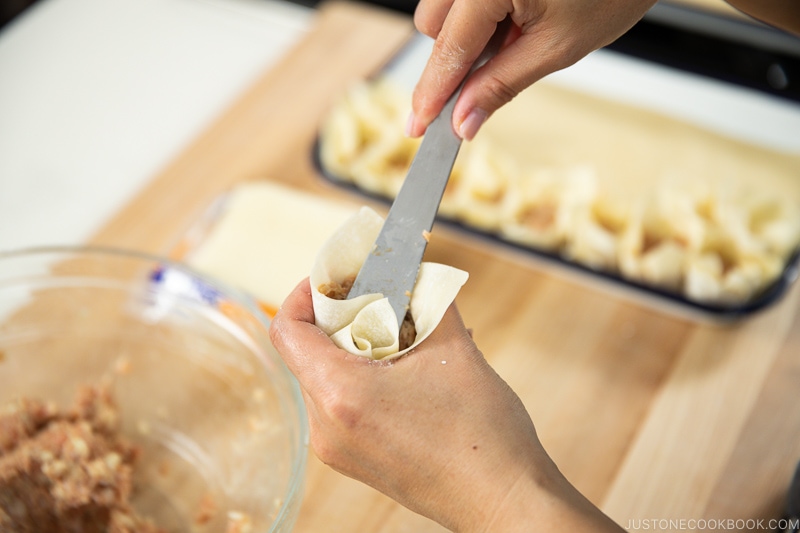
Press the meat down into the wrapper to avoid trapping air. Make sure to press at a 45-degree angle each time so that the meat mixture goes into the wrapper evenly.
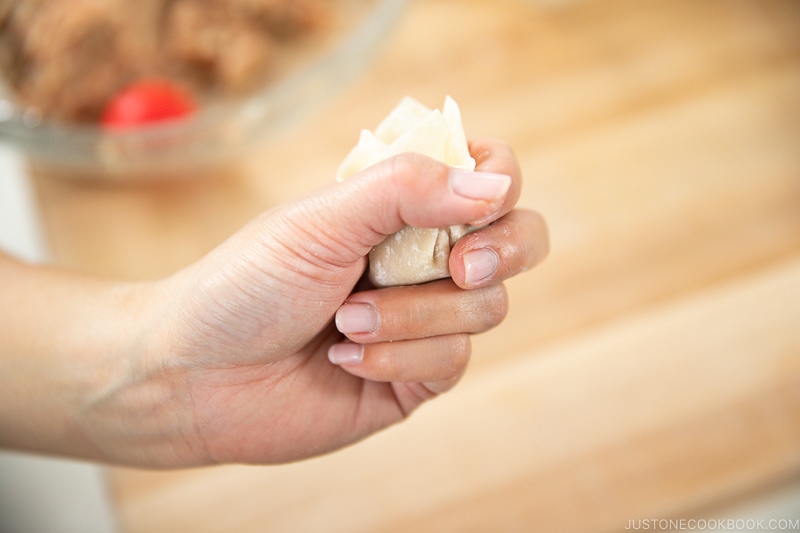
See the photo above. Create a hole with your thumb and index finger so that the wrapper sinks into the hole as you press down the meat mixture. To create a flat base, make sure your ring finger and pinky are at the bottom of the shumai.
How to Steam Shumai
I use a bamboo basket to steam the shumai, as it is the traditional way of cooking these dumplings. Here are a few tips for steaming them:
- Place parchment paper (with a few air vent holes made with the tip of a knife or chopstick) or cabbage leaves on the bottom of the steamer basket to prevent the shumai from sticking.
- When placing the shumai inside the basket, ensure they are not touching each other.
- Fill a large steamer pot with 1-2 cups of water. The water should not touch the bottom of the bamboo basket.
- Bring the water to a boil over high heat. Once boiling, place the bamboo basket on top of the wok and steam for 8-10 minutes, or until the meat is cooked through.
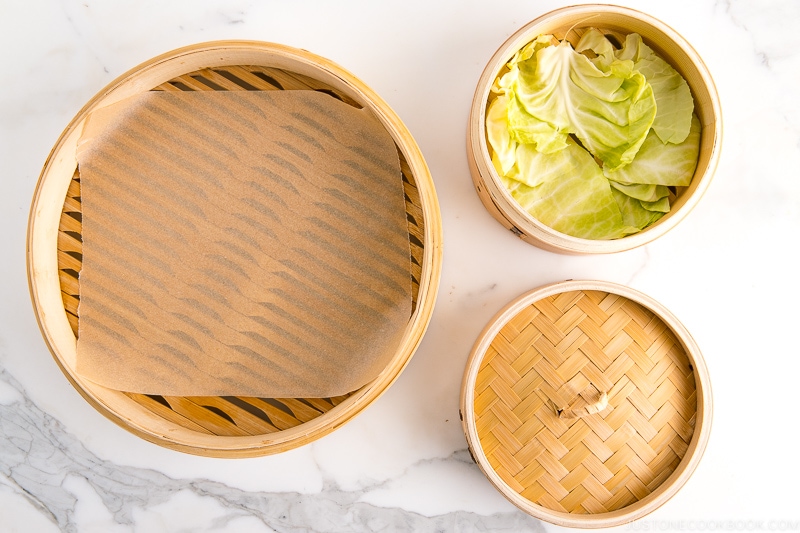
You can buy a bamboo steamer basket from Amazon or Asian grocery stores. I purchased my large bamboo steamer at an Asian grocery store and a small one from Japan.
No Steamer? Create a Makeshift Steamer!
No worries if you don’t steam food often enough to buy a steamer rack or bamboo steamer basket. You can make it work with a large pot, aluminum foil, and a plate!
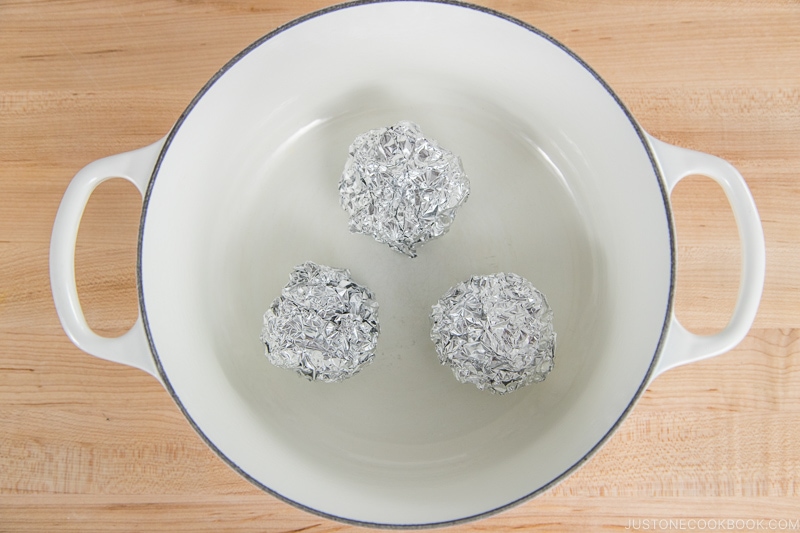 Make three tennis-size balls with aluminum foil and place them on the bottom of your cast iron pot.
Make three tennis-size balls with aluminum foil and place them on the bottom of your cast iron pot. 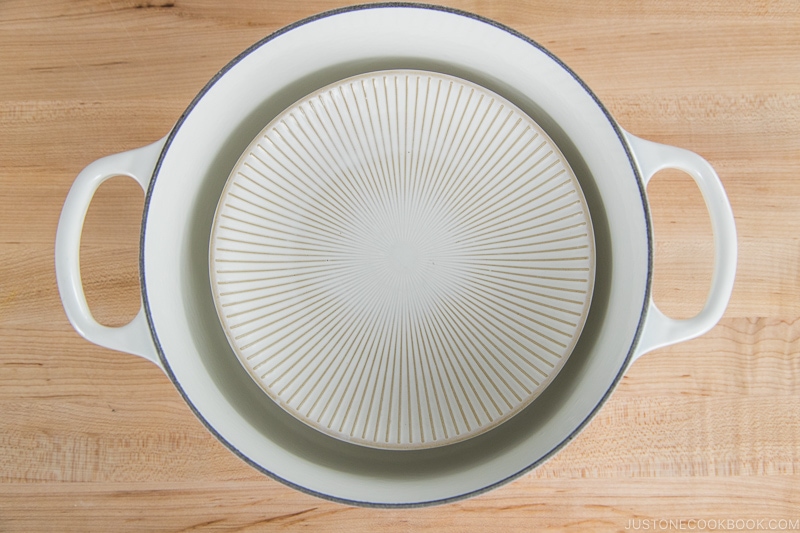 Add 1-2 inches of water and place a ceramic plate on the tinfoil balls. You can grease or put parchment paper before you place Shumai on top.
Add 1-2 inches of water and place a ceramic plate on the tinfoil balls. You can grease or put parchment paper before you place Shumai on top. 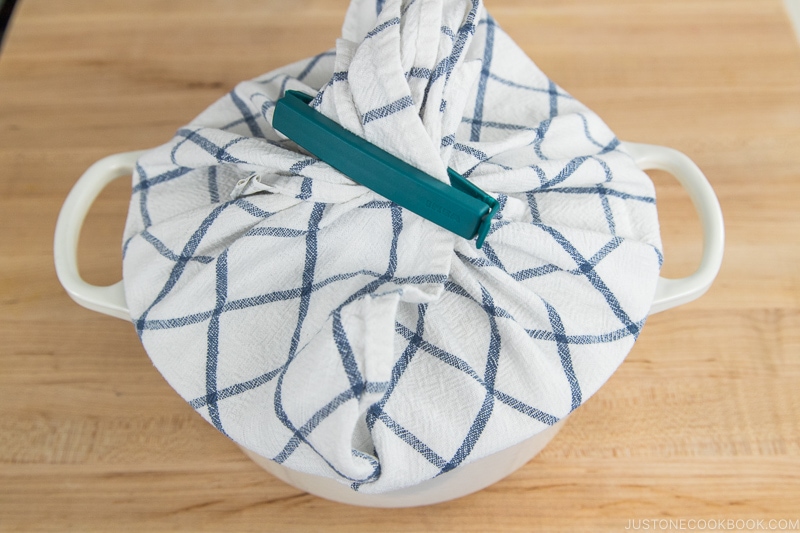 If your lid is flat, cover it with a large kitchen towel so condensation won’t drip and make the food soggy.
If your lid is flat, cover it with a large kitchen towel so condensation won’t drip and make the food soggy.
How to Make-Ahead and Freeze
The great thing about making shumai at home is that you can freeze them both before and after steaming. This means you can cook a big batch and enjoy them anytime. Right before serving, simply steam the frozen shumai without thawing.
To freeze, place uncooked shumai on a tray in a single layer. Once they are completely frozen, transfer them to an airtight container or bag.
What to Do with Leftover Wonton Wrappers
When I make shumai at home, I always use the leftover wrappers to make cheese wraps. Both pan-fried and deep-fried cheese wraps are easy to prepare, and your leftover wrappers won’t go to waste!
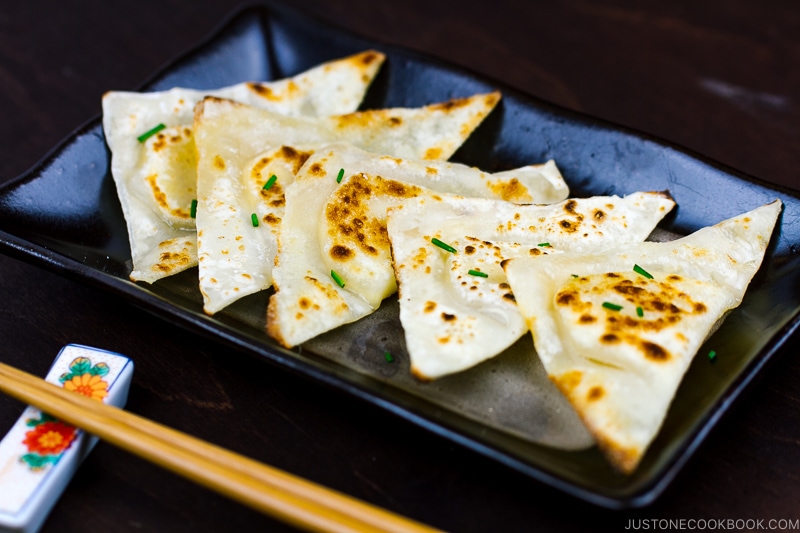
How to Enjoy Pork Shumai
These juicy, tender pork shumai make the best thing to enjoy for a weeknight meal. We usually serve them with Japanese karashi mustard, then dip them in soy sauce or a simple sauce made with soy sauce, vinegar, and chili oil. However, I enjoy eating them without sauce since the filling is so flavorful.
Shumai may seem challenging to make at first glance, but you’d be surprised how easy it is to replicate these all-star dumplings at home. They taste just as good as the ones served at fancy restaurants, but certainly much better than the frozen shumai you get from the stores.
I love making shumai with my children for a relaxing weekend brunch. The dumplings are so fresh and juicy that you want to eat them right off the bamboo basket!
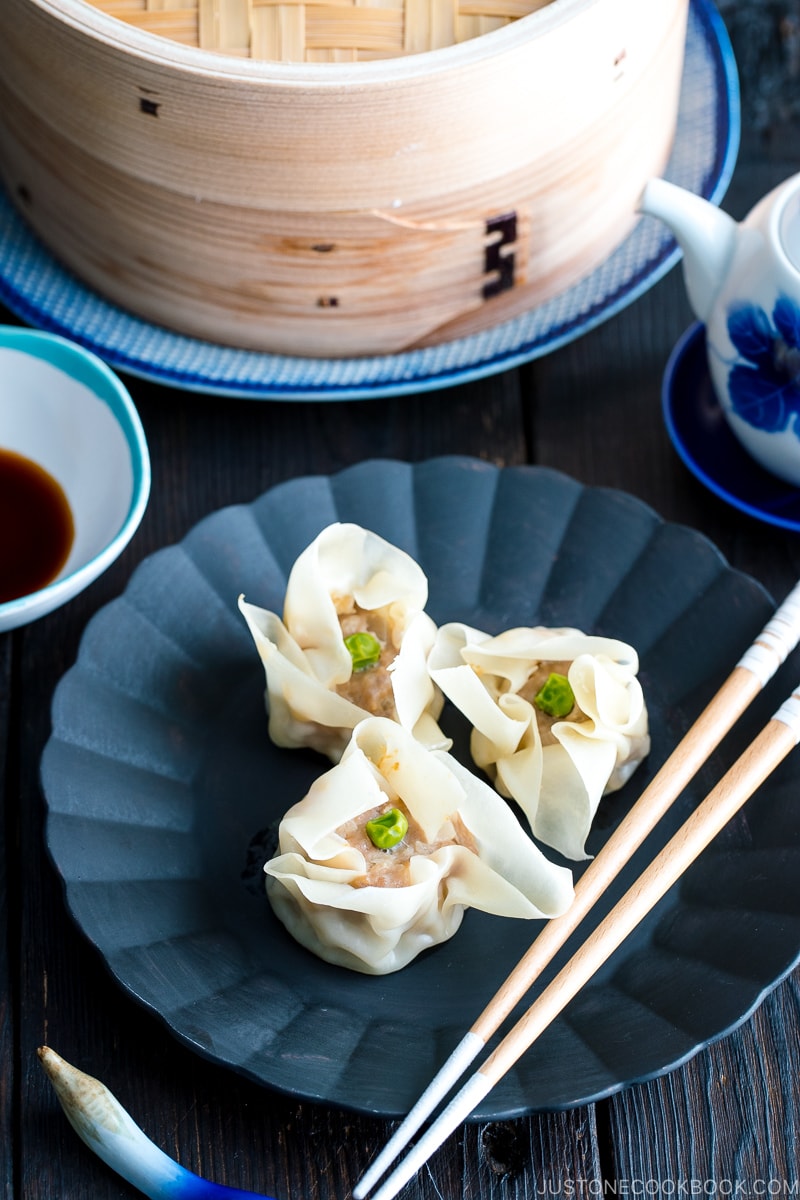
Other Dumpling Recipes
- Gyoza
- Shrimp and Pork Wonton Soup
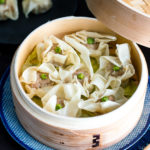
Pork Shumai (Steamed Pork Dumplings)
from votes Make fresh and juicy Japanese Shumai (Steamed Pork Dumplings) at home with ground pork and savory seasonings. They are perfect for a party appetizer or a weekend brunch. Introduced from China in 1928, Shumai are now a staple of Yokohama, Japan! Print Pin Prep Time: 50 minutes Cook Time: 10 minutes Total Time: 1 hour Servings: 35 Shumai
Ingredients US CustomaryMetric 1x2x3x
For the Filling
- ▢ ¾ onion (7 oz, 200 g)
- ▢ 2½ Tbsp potato starch or cornstarch
- ▢ 14 oz ground pork (⅞ lb)
- ▢ 1 tsp ginger (grated, with juice; from a 1-inch, 2.5-cm knob)
- ▢ 1 Tbsp sake
- ▢ ½ Tbsp toasted sesame oil
- ▢ 2 tsp sugar
- ▢ 1 Tbsp soy sauce
- ▢ ½ tsp Diamond Crystal kosher salt
- ▢ ⅛ tsp white pepper powder
For the Dumplings
- ▢ 35 wonton wrappers
- ▢ 3 Tbsp green peas (1 oz)
For the Dipping Sauce
- ▢ soy sauce
- ▢ rice vinegar (unseasoned)
- ▢ la-yu (Japanese chili oil) (optional; store bought or make my Homemade La-yu)
- ▢ Japanese karashi hot mustard (optional)
Japanese Ingredient Substitution: If you want substitutes for Japanese condiments and ingredients, click here. Cook ModePrevent your screen from going dark
Instructions
- Gather all the ingredients.
![Shumai Ingredients]()
To Make the Filling
- Mince the onion finely. Lay ¾ onion flat side down on the cutting board. With the knife tip pointing toward the root end, make ⅛-inch vertical slices to within ½ inch of the root end. Then, with the knife edge toward the root end, make ⅛-inch horizontal slices, again keeping the root intact.
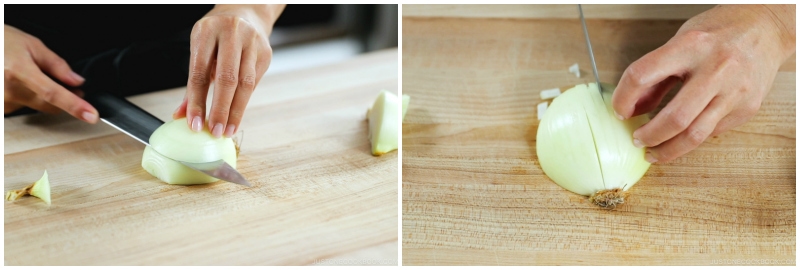
- Finally, make perpendicular cuts down through the vertical slices you made. To mince the onion pieces finer, run your knife through them using a rocking motion while holding down the tip of the knife.
![Shumai 2]()
- Put the finely minced onion in a large bowl and add 2½ Tbsp potato starch or cornstarch. Mix together.
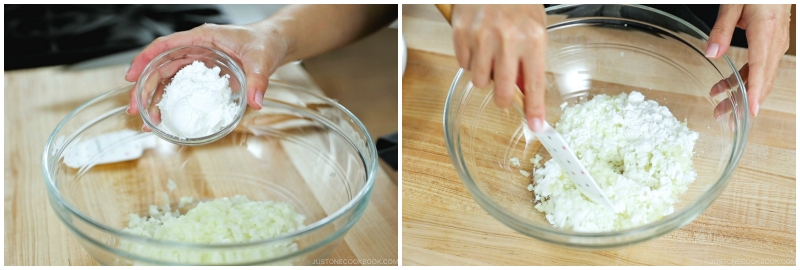
- With a knife, scrape off the skin of the ginger and grate it. You will need 1 tsp ginger (grated, with juice).
![Shumai 4]()
- In a medium bowl, combine 14 oz ground pork, the grated ginger with juice, 1 Tbsp sake, and ½ Tbsp toasted sesame oil.
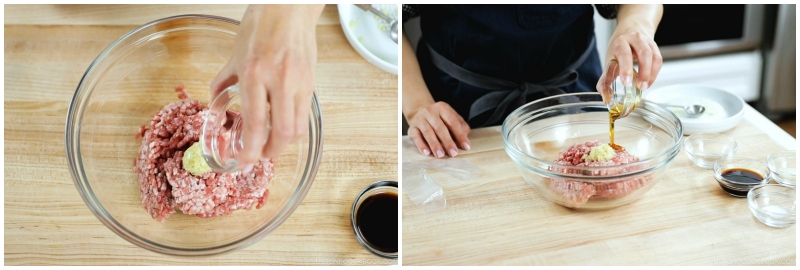
- Add 2 tsp sugar and 1 Tbsp soy sauce.
![Shumai 6]()
- And ½ tsp Diamond Crystal kosher salt and ⅛ tsp white pepper powder.
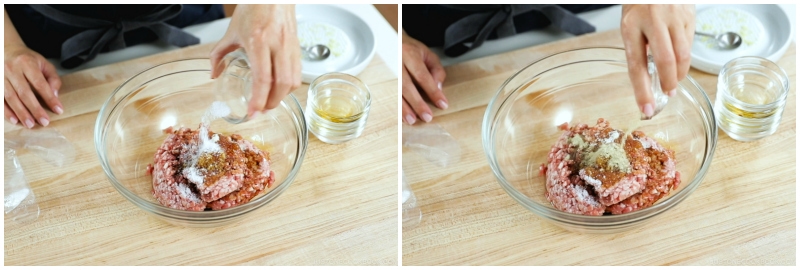
- Using your hands (or with plastic food gloves), knead the meat mixture until it‘s pale, sticky, and pasty.
![Shumai 8]()
- Then, transfer the meat to the bowl with the onion.
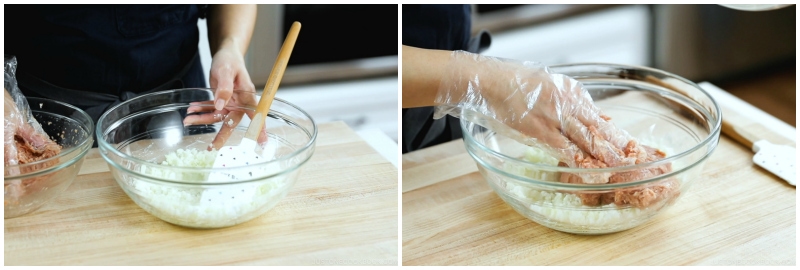
- Mix the onion and meat together until well combined.
![Shumai 10]()
To Wrap the Shumai
- Prepare 35 wonton wrappers, a baking sheet lined with parchment paper, a 1 Tbsp measuring spoon, and a butter knife. Make sure the wonton wrappers are covered in plastic wrap or a damp towel while you stuff the filling so they don‘t dry out.
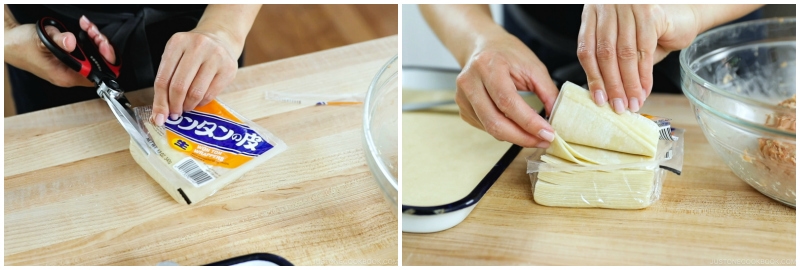
- Scoop the filling into the measuring spoon and level the meat off with the knife. Transfer the filling to the center of a wonton wrapper.
![Shumai 12]()
- Using your left hand (if you’re a righty), make a round hole by connecting your thumb and index finger with the rest of fingers next to each other. Place a wonton wrapper with the filling on top of it. Tip: Once you get used to making shumai, you can place the wrapper and then directly put the filling on top, instead of using a measuring spoon.
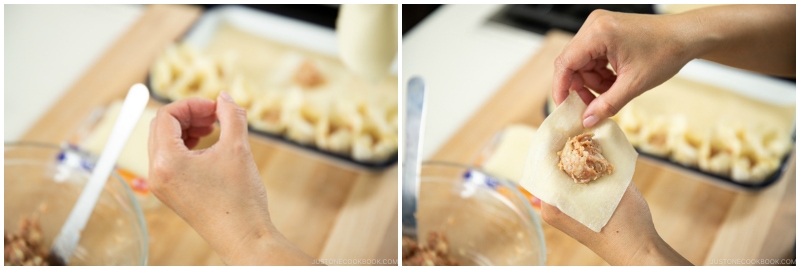
- Using the butter knife or the back of a teaspoon, gently press the filling down while holding the fingers firmly. After you press the meat down, rotate the shumai 45 degrees so the meat is evenly distributed in the center of the wrapper. Finally, smooth out the surface of the meat.
![Shumai 14]()
- Your left fingers should look like this while you press the meat inside, the ring finger and pinky right underneath the bottom of the shumai to create the flat base. Continue with the rest of the wrappers and filling until one of them runs out.
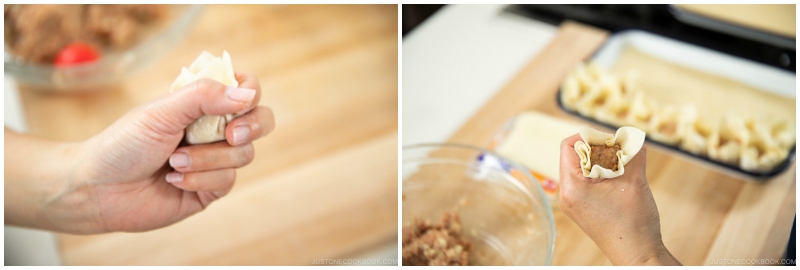
To Steam the Shumai
- When you finish wrapping, bring 1–2 cups of water in a wok (or steamer) to boil over high heat (or medium-high heat if you’re using nonstick). Make sure the water does not touch the bottom of the bamboo steamer basket. Meanwhile, with 3 Tbsp green peas, place a pea in the center of each shumai. Tip: If you don’t have a steamer, read my blog post above on how to steam shumai without a steamer.
![Shumai 16]()
- Prepare a piece of parchment paper (make a few air vent holes) or cabbage leaves and place them on the bottom of the steamer basket to prevent the shumai from sticking. Put the dumplings on top without touching each other. Most likely, you will need to steam them in batches. When the water is boiling, place the bamboo steamer basket onto the wok and steam for 8–10 minutes until the meat is cooked through.
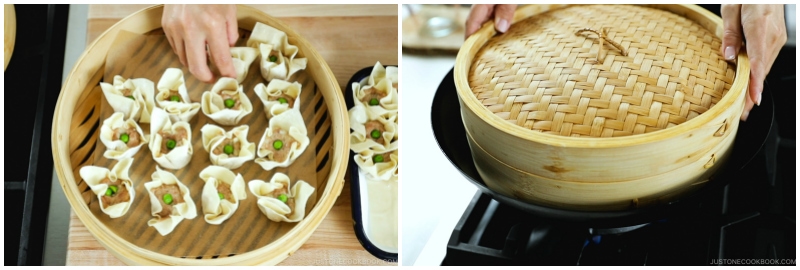
- After 8–10 minutes, check to see if the meat is cooked through. Then transfer the bamboo steamer basket on top of a large plate.
![Shumai 18]()
To Serve
- Bring to the table and serve immediately. Make a dipping sauce in individual sauce plates with soy sauce, rice vinegar (unseasoned), la-yu (Japanese chili oil) and Japanese karashi hot mustard.
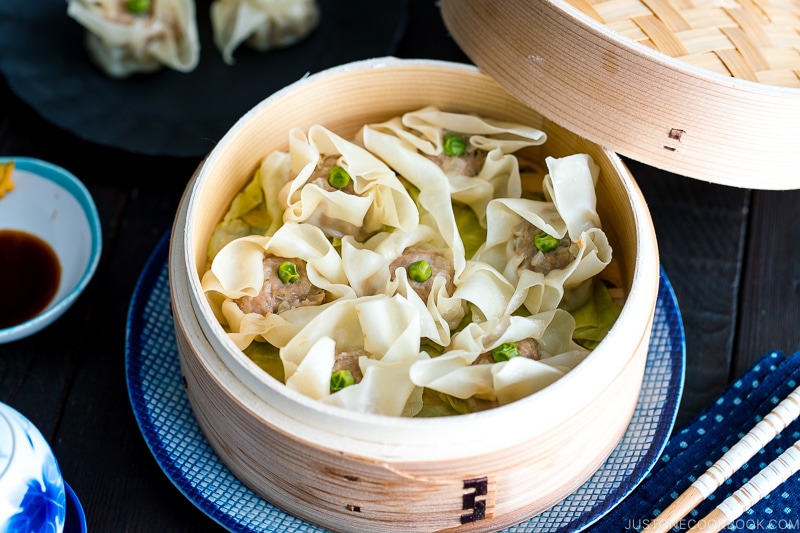
To Store
- You can freeze the dumplings before or after steaming them. Place each shumai on a baking sheet lined with parchment paper without touching each other, and flash freeze for 1 hour. Once frozen, transfer to a freezer bag. You can steam frozen shumai without thawing (just steam for an extra few minutes).
Nutrition
Calories: 59 kcal · Carbohydrates: 6 g · Protein: 3 g · Fat: 3 g · Saturated Fat: 1 g · Cholesterol: 9 mg · Sodium: 77 mg · Potassium: 52 mg · Fiber: 1 g · Sugar: 1 g · Vitamin A: 12 IU · Vitamin C: 1 mg · Calcium: 6 mg · Iron: 1 mg Course: Main CourseCuisine: JapaneseKeyword: dumpling, pork ©JustOneCookbook.com Content and photographs are copyright protected. Sharing of this recipe is both encouraged and appreciated. Copying and/or pasting full recipes to any website or social media is strictly prohibited. Please view my photo use policy here.
Editor’s Note: This post was originally published on February 20, 2012. It was updated with the video and new on April 5, 2020, and republished with more helpful information on August 20, 2024.


